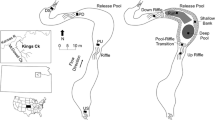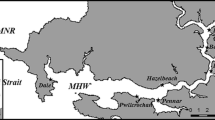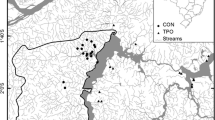Abstract
Animals in the intertidal, both mobile and sessile, generally exhibit some zonation pattern, in which each species shows a preference for, or is confined to, some height levels. The study of zonation patterns is, however, almost exclusively based on surveys made during low tide, when many animals are relatively inactive. We studied zonation patterns of amphipods and isopods on rocky shores in southwestern Iceland, both by traditional sampling at low tide as well as by sampling during high tide. The distributional patterns seen at high tide differed significantly from that at low tide. One amphipod, Anonyx sarsi, was common around baits at all levels at high tide but absent from the intertidal at low tide. Several other species were either relatively more common or tended to be recorded higher, or in one instance, lower on the shore when the tide was in than at low tide. There was also evidence of some species changing habitats within the intertidal with the tidal cycle. Many species, however, moved little away from their respective zones occupied at low tide, and for some species, including some capable of rapid swimming, very limited mobility was indicated. We conclude that low-tide surveys of the intertidal give an incomplete picture of the community structure, and even key species may be missed in such surveys.




Similar content being viewed by others
References
Alerstam T, Gudmundsson GA, Johannesson K (1992) Resources for long distance migration: intertidal exploitation of Littorina and Mytilus by knots Calidris canutus in Iceland. Oikos 65:179–189
Armonies W (1994) Drifting meio- and macrobenthic invertebrates on tidal flats in Köningshafen: a review. Helgol Meeresunters 48:299–320
Black R, Miller RJ (1991) Use of the intertidal zone by fish in Nova Scotia. Environ Biol Fish 31:109–121
Brown AC, McLachlan A (1990) Ecology of sandy shores. Elsevier, Amsterdam
Cruz-Rivera E, Hay ME (2000) The effects of diet mixing on consumer fitness: macroalgae, epiphytes, and animal matter as food for marine amphipods. Oecologia 123:252–264
Dahl E (1973) Ecological range of Baltic and North Sea species. Oikos 15[Suppl]:85–90
Dieleman J (1977) Circatidal activity rhythms and the annual migration cycle in an estuarine population of Gammarus zaddachi Sexton, 1912. Crustaceana 4[Suppl]:81–87
Dorgelo J (1977) Comparative ecophysiology of two intertidal gammarids and the problem of zonation. Crustaceana 4[Suppl]:64–80
Fincham AA (1972) Rythmic swimming and rheotropism in the amphipod Marinogammarus marinus (Leach). J Exp Mar Biol Ecol 8:19–26
Gibson RN (2003) Go with the flow: tidal migration in marine animals. Hydrobiologia (in press)
Hager RP, Croker RA (1980) The sand-burrowing amphipod Amphiporeia virginiana Shoemaker 1933 in the tidal plankton. Can J Zool 58:860–864
Hunter E, Naylor E (1993) Intertidal migration by the shore crab Carcinus maenas. Mar Ecol Prog Ser 101:131–138
Ingólfsson A (1977) Distribution and habitat preferences of some intertidal amphipods in Iceland. Acta Nat Islandica 25:1–28
Ingólfsson A (1998) Dynamics of macrofaunal communities of floating seaweed clumps off western Iceland: a study of patches on the surface of the sea. J Exp Mar Biol Ecol 231:119–137
Ingólfsson A (2000) Colonization of floating seaweed by pelagic and subtidal benthic animals in southwestern Iceland. Hydrobiologia 400:181–189
Ingólfsson A, Agnarsson I (1999) Anonyx sarsi: a major unrecognized scavenger and predator in the intertidal zone. J Mar Biol Assoc UK 79:1127–1128
Jormalainen V, Honkanen T, Heikkilae N (2001) Feeding preferences and performance of a marine isopod on seaweed hosts: cost of habitat specialization. Mar Ecol Prog Ser 220:219–230
Leifsson BR (1998) Life cycles, breeding periods and vertical distribution of Idotea granulosa Rathke and I. pelagica Leach (Crustacea, Isopoda) on Icelandic shores. Sarsia 83:1–13
Little C, Kitching JA (1996) The biology of rocky shores. Oxford University Press, Oxford
McBane CD, Croker RA (1983) Animal-algal relationships of the amphipod Hyale nilssoni (Rathke) in the rocky intertidal. J Crust Biol 3:592–601
Osterling M, Pihl L (2001) Effects of filamentous green algal mats on benthic macrofaunal functional feeding groups. J Exp Mar Biol Ecol 263:159–183
Pederson JB, Capuzzo JM (1984) Energy budget of an omnivorous rocky shore amphipod, Calliopius laeviusculus (Kroeyer). J Exp Mar Biol Ecol 76:277–291
Raffaelli D, Hawkins SJ (1996) Intertidal ecology. Chapman and Hall, London
Raffaelli D, Richner H, Summers R, Northcott S (1990) Tidal migrations in the flounder (Platichthys flesus). Mar Behav Physiol 16:249–260
Rangeley RW, Kramer DL (1995a) Use of rocky intertidal habitats by juvenile pollock Pollachius virens. Mar Ecol Prog Ser 126:9–17
Rangeley RW, Kramer DL (1995b) Tidal effects on habitat selection and aggregation by juvenile pollock Pollachius virens in the rocky intertidal zone. Mar Ecol Prog Ser 126:19–29
Sars GO (1890–1995) An Account of the Crustacea of Norway, vol 1. Amphipoda. Cammermeyer, Christiania
Sjöberg B (1967) On the ecology of the Jaera albifrons group (Isopoda). Sarsia 29: 321–348
Takeuchi I, Hirano R (1995) Clinging behaviour of the epifaunal caprellids (Amphipoda) inhabiting the Sargassum zone of the Pacific coast of Japan, with its evolutionary implications. J Crust Biol 15:481–492
Warman CG, Reid DG, Naylor E (1993) Variation in the tidal migratory behaviour and rythmic light-responsiveness in the shore crab, Carcinus maenas. J Mar Biol Assoc UK 73:355–364
Watkin EE (1941) Observations on the night tidal migrant crustacea of Kames Bay. J Mar Biol Assoc UK 25:81–96
Acknowledgements
A large number of assistants have, over the years, taken part with me in surveying rocky shores of southwestern Iceland. These are too numerous to mention individually, but Maria B. Steinarsdóttir deserves special thanks for outstanding work over a number of years. We also wish to thank Magnea Karlsdóttir and Svava S. Steinarsdóttir for their large part in operating the traps and sorting their contents, and Karl Gunnarsson for diving for Ascophyllum samples. The study was to a considerable extent financed through grants from the RANNIS Science Fund. We thank Jörundur Svavarsson and Laura May-Collado for their helpful comments on a version of this manuscript. All handling of animals in this study has been in accordance with Icelandic laws.
Author information
Authors and Affiliations
Corresponding author
Additional information
Communicated by L. Hagermann, Helsingør
Rights and permissions
About this article
Cite this article
Ingólfsson, A., Agnarsson, I. Amphipods and isopods in the rocky intertidal: dispersal and movements during high tide. Marine Biology 143, 859–866 (2003). https://doi.org/10.1007/s00227-003-1132-6
Received:
Accepted:
Published:
Issue Date:
DOI: https://doi.org/10.1007/s00227-003-1132-6




